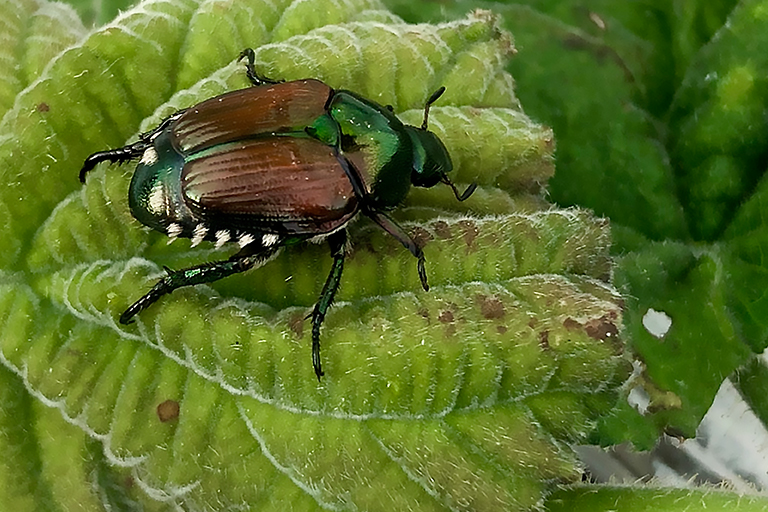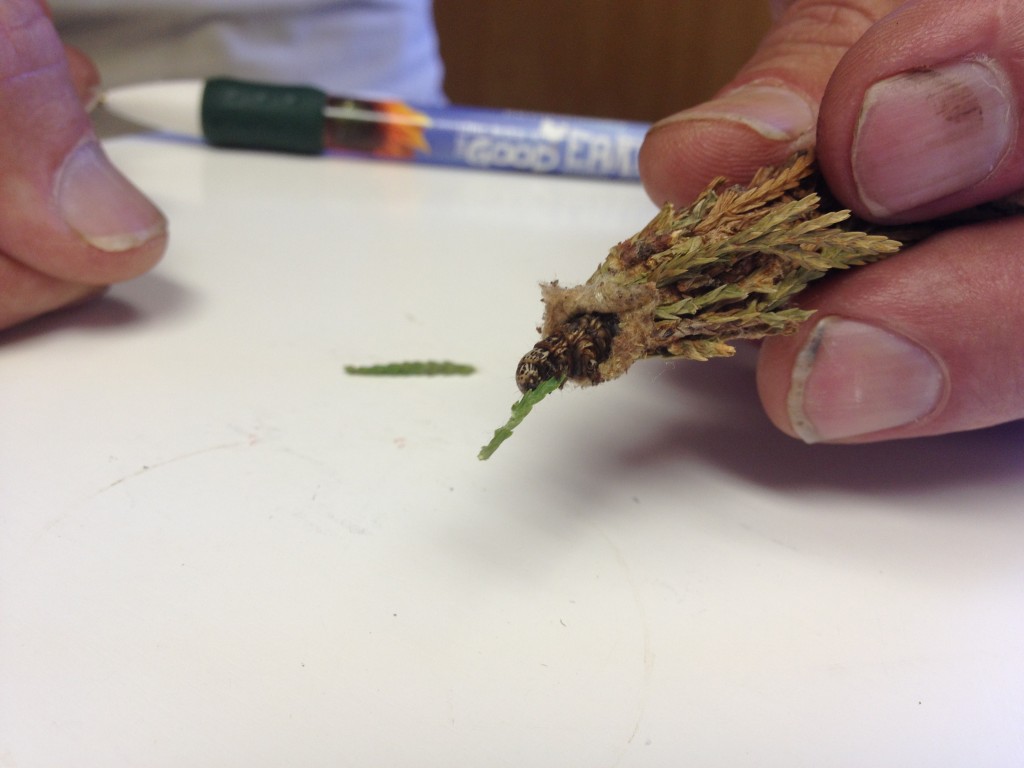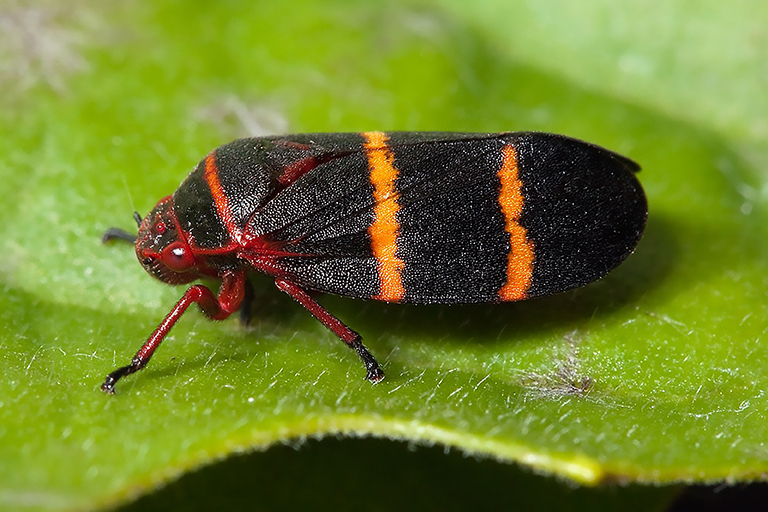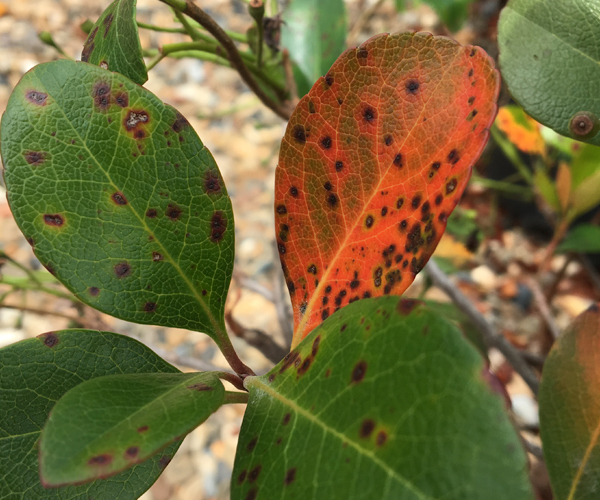Summer Landscape Pests

Japanese Beetle
We have been seeing a little bit of everything this summer. One thing is for sure, due to our warm, damp spring, and fairly mild summer, plant diseases and detrimental insect populations have flourished throughout landscapes in central Arkansas. It’s time to walk through your landscape and address issues before the heat sets in and further exacerbates possible infections of both diseases and insect infestations.
Many landscape pest can be prevented with proper watering and plant spacing. To avoid foliage diseases, water in the early morning instead of at night. With insects such as whiteflies, plant at good spacing intervals to insure good air flow. Once your landscape is in place, it’s almost inevitable that these pest will show up at some time and that controlling with chemicals may be necessary. Fall, winter and early spring sprays with Dormant Oil is a good way to preemptively treat for possible diseases and insects.
Keep reading for common landscape pests and issues we are seeing right now as well as control methods:

Bagworm
Bagworms
It’s a great time to start looking for this summer pest because timing is key in controlling it! Read our full blog post on bagworms here, including why waiting to treat is a bad idea. Last year, we saw bagworms on unusual host plants such as camellias so check landscapes carefully and thoroughly. More common hosts include conifers such as juniper, arborvitae, cypress, pine, and cedar. Products containing one of the following active ingredients will control this pest: spinosad (Ferti-Lome Natural Guard Spinosad), bacillius thuringiensis (Ferti-Lome Natural Guard Caterpillar Killer Spray with Bt), acephate (Bonide Systemic Insect Control), permethrin (Hi-Yield 38 Plus).
Japanese Beetle
We have a whole post on these; here is a link to it. The image at the top of this post is of a Japanese Beetle; be on the look out. They can do a tremendous amount of damage in a short time; and when they find a tasty plant, they communicate it to friends and they quickly join the feast!

Spittlebug
Spittlebugs in Zoysia and St. Augustine lawns
One of the main reasons we blog about issues like this is to illuminate issues that may be occurring in your landscape right now, unbeknownst to you! Spittlebugs are black leafhoppers that have two red-orange stripes across the back. While in the nymph stage, spittlebugs suck plant juices from some of our commonly used turfgrasses such as zoysia grass and St. Augustine grass. This weakens the grasses, causing them to turn yellow then brown and in severe cases, the grasses may not recover. Acephate (Bonide Systemic Insect Control) is an effective control method. Here is a link to more spittlebug info.
Scale
Scale can be commonly found on magnolias, crapemyrtles, and many other plants. Treat with Dormant Oil when seasonally appropriate (link to that post here), Triple Action containing Neem, Ferti-Lome Tree and Shrub Systemic Insect Drench as well as other chemicals that list scale as a controlled pest.
Whiteflies
These can be on several different plants but are very common on both gardenias and hibiscus plants. When you brush up against the plants, clouds of well, white flies emerge. Also check the back of the leaves for translucent oval eggs and nymphs. Control with HiYield Systemic Insect Granules or other chemicals that list whiteflies as a controlled pest. Treating with Dormant Oil and Ferti-Lome Tree and Shrub Systemic Insect Drench earlier in the year is a good preventative measure if you have had them in the past.
Spider Mites
These are tiny red mites that are in the spider family. Unless you look at them under a microscope, you most likely won’t see the similarities though. This pest is commonly found on houseplants like ivy, as well as evergreens like spruce and herbs such as rosemary, vegetable crops and perennials like mazus and verbena. Yes, they have many plant hosts! Look for stippled leaves showing a rust color and tight little webs. Tap a branch against a white piece of paper and look at it closely for these tiny pests.
Spinosad, Triple Action contain Neem, Ferti-Lome Tree and Shrub Systemic Insect Drench are some of the control methods but there are others. Timing is key; once you know you have this pest, we can help you figure out the best control for the time of year and severity of infestation.
Rose Rosette Virus
One of our beloved landscape plants, the rose, has been increasingly affected by this virus, which is spread by mites. Symptoms include thickened stem growth, excessive thorns, witches’ broom growth at end of stems, branch dieback, discolored and distorted leaves. Unfortunately, there is no cure for viruses and affected plants will need to be removed. For existing, unaffected roses, treat with dormant oil after cutting back in February, which will help control overwintering mites.
For full blog post, follow this link.
Black Spot
The most common host plant for black spot is the rose. One of the best control methods is to plant varieties that are resistant to the disease such as those in the KnockOut and Drift roses. Diseases such as black spot, leaf spot and powdery mildew are prevalent after periods of warm, damp weather. Avoid watering the foliage as much as possible, and provide good air flow with appropriate plant placement. Black spot symptoms include leaf spots and severe leaf drop. As leaves drop, remove them to reduce disease spread. As the plant goes dormant, remove leaves and debris for the same reason. For plants with a history of black spot, preventative treatments should be applied as the plants sprout new growth in the spring. Treat with propiconizole (Ferti-Lome Liquid Systemic Fungicide II), Bonide Copper Fungicide, tebuconazole (Bayer All-In-One Rose and Flower Care) or other fungicides labeled for black spot control.

Leaf Spot
Entomosphorium Leaf Spot
The most common host plants for this disease are Indian hawthorn and red tip photinia. In fact, this disease is so prevalent and damaging to red tip photinias that we have stopped carrying this plant, although many can be seen around town. There are disease resistant varieties of Indian hawthorn such as Snow White but if conditions are just right (again humid, frequent rain, warm temperatures), any variety could become affected. As with other plant diseases, avoid watering foliage if possible, and provide good air flow. Remove any dropped leaves and treat with propiconizole (Ferti-Lome Liquid Systemic Fungicide II), Bonide Copper Fungicide or other fungicides labeled for leaf spot control. For plants with a history of disease, apply preventative sprays in the spring as new growth emerges.
Powdery Mildew
Powdery mildew may affect a variety of plants such as dogwood trees, crapemyrtles, lilac, monarda, and more. Symptoms include gray-white powdery looking areas on foliage, distorted foliage and leaf drop. Choosing resistant plant varieties, providing good air flow, clean-up of dropped leaves and avoiding overhead watering will help control the occurrence and spread of this disease. Treat with propiconizole (Ferti-Lome Liquid Systemic Fungicide II), Bonide Copper Fungicide or other fungicides labeled for powdery mildew. For plants with a history of disease, apply preventative sprays in the spring as new growth emerges.
Large Patch/ Zoysia Patch
Our common turf grasses including zoysia, bermuda, St. Augustine, and centipede grasses are susceptible to this disease. Symptoms include large semi-circular, circular or arc shaped area with damaged turf including yellowed leaf blades. In zoysia, the interface between healthy lawn and diseased areas might become bronze or orange. As with most diseases, cultural control is important. Avoid high nitrogen applications in early spring, night watering and over watering. De-thatch areas with over 1/2 inch of thatch. Apply mycobutanil (Ferti-Lome F-Stop) or other labeled products for systemic control. Treatment may be required for several growing seasons for good control.
Drainage Issues
Last but not least, this rainy spring and early summer paired with our typically poor draining, heavy soils has caused visible issues. We have had many visitors bring pictures or plant samples showing symptoms such as yellowed leaves, branch dieback, and wilting. Unfortunately, the symptoms for over or under watering and poor drainage can look similar; proper assessment includes considering rainfall, watering schedule and maybe most importantly, how well the soil drains.
In an ideal situation, there are equal parts solid matter and pore space voids which may be filled with air and water. In poorly drained soil, these pore spaces are filled with water for too long, which suffocates plant roots due to lack of oxygen. If a large area is consistently wet, consider planting with water loving plants as amending the soil might be cost prohibitive. Smaller, more manageable areas can be addressed by raising the beds, adding a drainage system, re-grading and most importantly, amending the planting area. If your landscape is already installed and you are trying to figure out what is happening in the root zone of your plants, you need a moisture meter. They are inexpensive ($10), and will provide you with useful input on what is really happening below the surface. Keep in mind that plants may have experienced stress and some root decline due to excessive rain and poor drainage this spring, and not show symptoms until the heat arrives this summer.
Bring us Samples!
This is a few of the common summer landscape pests but there are more! It can be difficult to diagnose issues without images or leaf samples; the more information you can provide, the better. We encourage you to take a walk through your landscape weekly and come see us or email us about any issues so we can help you properly address them!